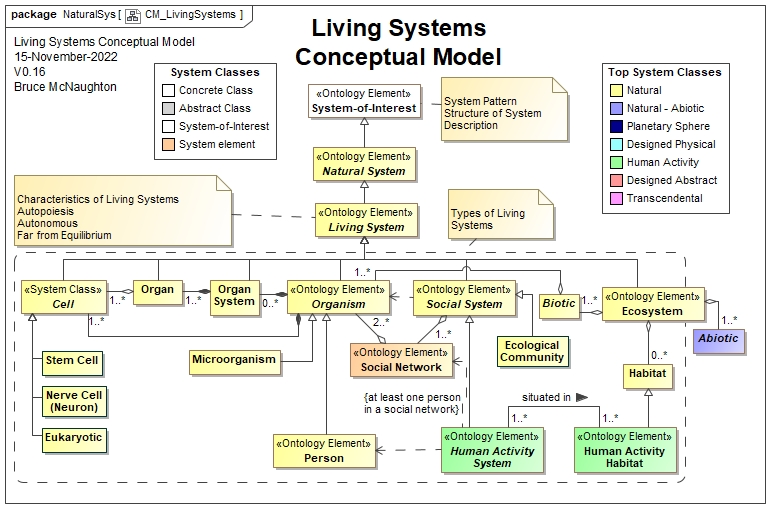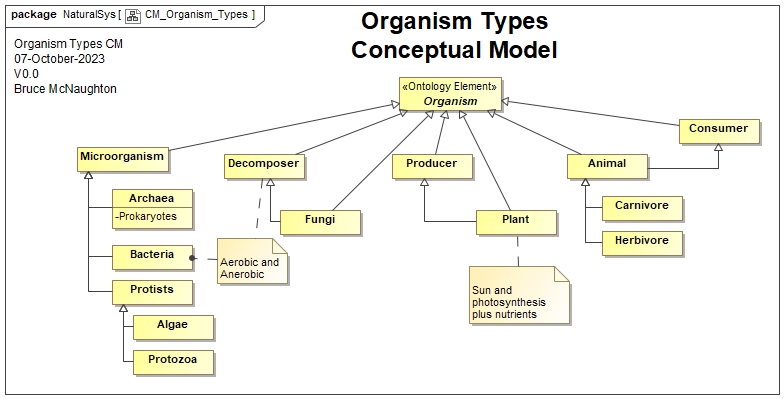View: System Name and Class
This section identifies the system of interest for this system description
Name: Ecosystem
Based on: Living System

System Level Foundations
Ecosystem: An ecosystem (or ecological system) consists of all the organisms and the physical environment with which they interact.[2]: 458 These biotic and abiotic components are linked together through nutrient cycles and energy flows.
Abiotic Component: In biology and ecology, abiotic components or abiotic factors are non-living chemical and physical parts of the environment that affect living organisms and the functioning of ecosystems. Abiotic factors and the phenomena associated with them underpin biology as a whole.
Biotic Component (see Ecosystem):
Habitat: In ecology, the term habitat summarises the array of resources, physical and biotic factors that are present in an area, such as to support the survival and reproduction of a particular species. A species habitat can be seen as the physical manifestation of its ecological niche. For terrestrial ecosystems, soil may be a key element of a habitat.
Habitat Type: Habitat types are environmental categorizations of different environments based on the characteristics of a given geographical area, particularly vegetation and climate.[2] Thus habitat types do not refer to a single species but to multiple species living in the same area. For example, terrestrial habitat types include forest, steppe, grassland, semi-arid or desert.
Species: In biology, a species is the basic unit of classification and a taxonomic rank of an organism, as well as a unit of biodiversity.
Respiration (physiology): In physiology, respiration is the movement of oxygen from the outside environment to the cells within tissues, and the removal of carbon dioxide in the opposite direction that's to the environment.[1]
Respiration (Cellular): Cellular respiration is the process by which biological fuels are oxidized in the presence of an inorganic electron acceptor, such as oxygen, to drive the bulk production of adenosine triphosphate (ATP), which contains energy. Cellular respiration may be described as a set of metabolic reactions and processes that take place in the cells of organisms to convert chemical energy from nutrients into ATP, and then release waste products.[1]
Photosynthesis: Photosynthesis (/ˌfoʊtəˈsɪnθəsɪs/ FOH-tə-SINTH-ə-sis)[1] is a biological process used by many cellular organisms to convert light energy into chemical energy, which is stored in organic compounds that can later be metabolized through cellular respiration to fuel the organism's activities.
Ecological Community: In ecology, a community is a group or association of populations of two or more different species occupying the same geographical area at the same time, also known as a biocoenosis, biotic community, biological community, ecological community, or life assemblage.
Carrying Capacity: The carrying capacity of an environment is the maximum population size of a biological species that can be sustained by that specific environment, given the food, habitat, water, and other resources available. The carrying capacity is defined as the environment's maximal load, which in population ecology corresponds to the population equilibrium, when the number of deaths in a population equals the number of births (as well as immigration and emigration). The effect of carrying capacity on population dynamics is modelled with a logistic function. Carrying capacity is applied to the maximum population an environment can support in ecology, agriculture and fisheries.
Food Web: A food web is the natural interconnection of food chains and a graphical representation of what-eats-what in an ecological community. Another name for food web is consumer-resource system.: Also called Trophic Network.
Biome: A biome /ˈbaɪoʊm/ is a large collection of flora and fauna occupying a major habitat.[1]
Ecotone: a region of transition between two biological communities
Sphere:
Ecological Niche: The fit within an ecosystem among all of the ecosystem species.
Ecological Boundary: a boundary around the ecosystem of interest or a boundary around a subset of the ecosystem.
NOTE:.The Ecological Boundary can be wide or narrow depending upon the boundary. In all cases, the structural model remains the same. The behaviour varies depending on the configuration (type) of ecosystem within the boundary. Here are some examples:
-
The Planet (Whole Earth) is the Boundary. The whole planet is included.
-
Biome is the boundary. The characteristics of the Biome determine the behaviours.
-
Nation is the boundary: The characteristics of the Nation may vary from regions to towns - however, the overall nation can be understood
-
City or neighbourhood is the boundary: Specific issues or problems can be identified locally and plans taken to address the issues.
-
Other ecosystem types with a boundary or ecosystem boundaries: These provide a narrow view in a wider context.
Types of organisms in an Ecosystem
